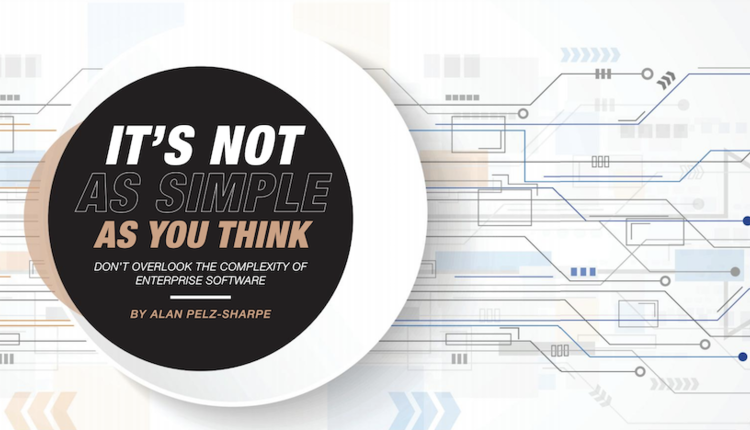
Even though industry analysts feel the need to label and sort enterprise technologies into neat silos, this practice has always been of limited value — as it often makes navigating a buyer toward the right product for their needs much harder than it should be. For example, once upon a time, we called it ‘workflow.’ That made sense, as this was a technology used to manage the ‘flow of work’… ergo ‘workflow’. Likewise, we used to call ‘document management,’ because it was a term used for the technologies you would manage documents with. You get the general drift.
Today, we live in a world of cognitive content services, ambient search and hyper-automation, with multiple sects, gangs and subgroups lurking around the corner from RPA to insight engines. All this effort to label, often entirely different products, into a single category helps nobody or very few. Take, for example, all the enterprise search tools in the market today. It’s in our nature to simplify things, but the ambiguities and differences between, say, the Microsoft Azure Cognitive Search product, ElasticSearch, Searchblox or Sinequa are essential to understand. They are all enterprise search products, but they are all quite different and incredibly complex.
Or, to put it into more practical and hypothetical terms, imagine that four technology vendors are designated as ‘leaders’ by the experts; I want the best technology, so I will look at these four and nothing else. It sounds sensible, but in our experience, this simplification process of identifying so-called leaders does little more than blinker and potentially blind you from finding the right solution to your needs. To quote Albert Einstein, “Everything should be made as simple as possible, but not simpler.” That’s our job as industry analysts, to remove the unnecessary complexity and focus on what matters. Let me give you an example. We wrote about Adobe Liquid Mode and Google Workspace, both interesting, but technically very different products in and of themselves. What we tried to highlight in our research was that they both enable accessibility features that are critical to hearing, sight or the motor-impaired, and improve everyone’s usability experience. We could have dived deeply into the underlying AI technology in both products, but to what end?
On one level, this is a screed against Magic Quadrants and Forrester Waves, but it is important to note that we know the analysts who write these reports and have huge respect for their work. Such reports have value and are typically compiled with rigor and draw upon extensive analysis and knowledge. But they are not and should never be used as an excuse to pull together a shortlist blindly. The value they bring is in measuring and comparing market leadership; not for creating a shortlist of products.
You, the buyer, need to find the right technical and cultural fit to meet your organization’s requirements. That’s a very different thing. It’s hard work, but it’s worth doing correctly. And the key to doing it correctly is to define your business problem first. Nobody has a CRM, ERP or ECM problem; they have real-world issues and improvements to address. Determine your goal first, figure out how to reach that goal; in many instances, you will find that you do not need to buy new enterprise software; in others, you may need to invest in technology and augment what you already have rather than rip and replace. Once you have identified what you want to achieve and how you will achieve it, you move forward.
If new technology is required, keep an open mind about which technology firm can best help you. Look at how others have solved similar problems and engage with your peers. In our experience, a good shortlist may well include a mix of different products that would live on different quadrants and waves. Assuming you have the budget, always bring the shortlisted vendors into your location, spend time with them, get to know them, and how they will approach this particular project. Again, in our experience, this is where surprises occur, often the ‘best’ technology is immediately discounted, and a lesser-known vendor emerges as the perfect fit.
So why do enterprises rely on quadrants and waves to select products? Well, typically, they use these constructs to save time and energy. Rather than spend months of research, they use Gartner or Forrester to create the shortlist under the theory the shortlist may not completely match the org’s needs, but it is good enough. In addition, quadrants and waves are perceived to reduce risk — if a vendor is on the list, the vendor has been vetted. If we do the research ourselves and find a small company that matches our needs, how do we know they will even be in business next year?
Though this all seems sensible and logical, it raises many issues. You may save a bit of time, but there is no reason to spend months researching a suitable shortlist; it’s not as demanding or arduous as you may imagine. Just because a product comes from a large technology vendor, the vendors that typically dominate MQ’s and Waves, there is no guarantee that the product will be around or supported in the future.
There are multiple reasons for this; though they may be a large vendor, this product may be an insignificant part of their overall business. Similarly, large vendors are always pushing you to move to the new version, platform or newly acquired product. In contrast, small vendors are typically dedicated to one product; it is what they do, period, and are in it for the long run. This being said, you always need to undertake some due diligence on how committed and sustainable the vendor or the product is, regardless of the size of the company.
As the occasionally accurate, Wikipedia defines it, “Categorization and classification allow humans to organize things, objects and ideas that exist around them and simplify their understanding of the world.” The keyword to note here is ‘simplify,’ and the danger we face is that enterprises often deal with highly complex situations requiring highly complex solutions.
Simplify, simplify, simplify was a mantra of the Quakers, and it’s a good one, but enterprise software isn’t simple, it’s complicated, and we need to respect that or face the consequences. For sure, technology vendors themselves are often poor at marketing and tend to overcomplicate the situation, focusing on their technology rather than the value it brings. But under the covers, a lot is going on, and significant differences in approach, architecture and how to deploy technologies effectively should never be ignored or unnecessarily simplified.





![GettyImages-1211616422-[Converted]](https://cms-static.wehaacdn.com/documentmedia-com/images/GettyImages-1211616422--Converted-.2413.widea.0.jpg)















